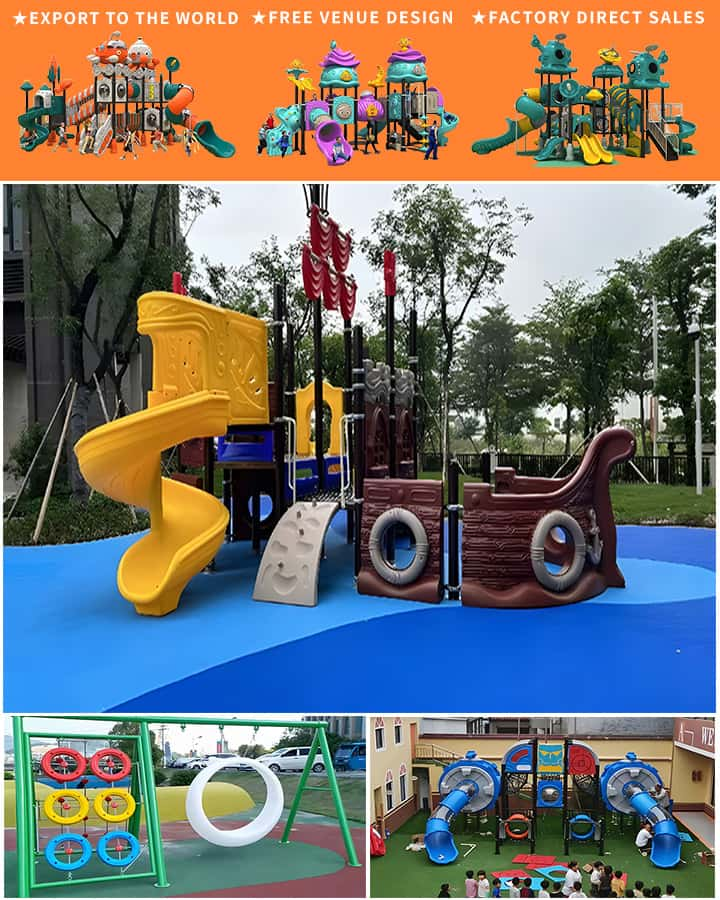Creating a large outdoor kids playground is an exciting venture, filled with opportunities to bring joy and laughter to children’s faces. Whether you’re planning for a community park, a school, or your own backyard, a well-designed playground can provide countless hours of fun and developmental benefits. This guide will cover key elements to consider when designing a large outdoor kids playground that is safe, enjoyable, and inclusive.
1. Safety First
Safety is paramount when it comes to playground design. Ensure that all equipment meets safety standards set by organizations such as the American Society for Testing and Materials (ASTM) or the Consumer Product Safety Commission (CPSC). Regular inspections and maintenance are also crucial to keep the playground in top condition.
- Soft Surfacing: Use rubber mats, wood chips, or other soft materials beneath play structures to cushion falls.
- Proper Installation: Hire professionals to install playground equipment correctly and securely.
- Supervision: Design areas where caregivers can easily supervise children at play.
2. Variety of Equipment
A diverse range of equipment caters to different age groups and abilities, ensuring that every child finds something enjoyable. Consider including:
- Slides and Swings: Classic choices that delight children of all ages.
- Climbing Structures: Ladders, ropes, and climbing walls help develop motor skills and build confidence.
- Balance Beams and Rope Bridges: These challenge coordination and balance, offering fun physical activity.

3. Inclusive Design
Inclusive playgrounds welcome children of all abilities. Incorporate elements like:
- Ramps Instead of Steps: For easy access for children using wheelchairs or strollers.
- Adaptive Play Equipment: Include items designed specifically for children with disabilities.
- Sensory Play Areas: Features like textured surfaces and musical instruments engage children with sensory processing needs.
4. Natural Elements
Incorporating natural elements can add an extra layer of engagement and education to the playground experience.
- Water Play: Fountains, splash pads, or small pools offer refreshing fun during hot weather.
- Sandpits: Great for creative building and digging games.
- Green Spaces: Grass, trees, and garden beds create a welcoming environment and teach kids about nature.
5. Themed Play Areas
Themed play areas can spark creativity and imagination. Ideas include:
- Pirate Ship: Climb aboard with slides and nets for an adventure on the high seas.
- Jungle Gym: Mimic a safari experience with tunnels, swinging ropes, and animal figures.
- Space Adventure: Futuristic structures like rockets and moonwalks inspire dreams of the cosmos.
6. Educational Opportunities
Playgrounds can be more than just fun—they can also be spaces for learning and exploration.
- Interactive Exhibits: Informational signs or interactive displays about science, history, or local flora and fauna.
- Challenge Courses: Obstacle courses that promote teamwork, problem-solving, and physical fitness.
- Gardening Areas: Small plots where children can plant and care for their own flowers or vegetables.
7. Community Involvement
Engage the local community in the design process to ensure the playground meets the needs and desires of its users. Organize workshops, surveys, or open forums to gather input from parents, teachers, and children.
By considering these elements, you can design a large outdoor kids playground that not only provides endless entertainment but also fosters physical, social, and cognitive development. With careful planning and a focus on safety and inclusivity, your playground can become a cherished space for children and families alike.




